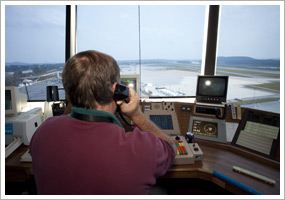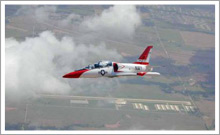Oct. 14, 2011, issue of 'AOPA ePilot: Flight Training Edition' newsletter
| ||||
| | FT News | INSIDE AOPA | TRAINING PRODUCTS | FINAL EXAM | |||
TRAINING TIPs Check in, speak up Use them to your advantage, and avoid developing the too-common habit of avoiding contact with ATC when the frequency crackles with communication. Sometimes, controllers say, they want to be in contact with VFR aircraft exactly when the local workload is at its peak. Surprised? Think about it from a radar approach controller’s viewpoint. Say you planned a flight from Brunswick Executive Airport in Maine to Limington-Harmon Airport. The route takes you near the northern boundary of Class C airspace centered on the Portland International Jetport. You determine that you can remain far enough away from the airspace boundary to make two-way radio communications with Portland Approach unnecessary. For extra reassurance you fly below the 1,500-foot floor of the outer ring until well clear. You are monitoring the approach frequency, and yes, there is a push on. Most aircraft are landing on Runway 11, but some are opting for Runway 18, accepting clearances to land and hold short of the runway intersection. Just before you fly across the Runway 18 final approach course, you spot one of the inbound aircraft dead ahead (at your altitude). That’s when a radar controller would want to be in contact with you. In that situation, you are having an effect on the flow. How? California air traffic controller Paul Langston discussed a similar scenario with a pilot who visited his ATC facility. “We have to restrict all of the arrivals inbound on that approach to avoid his aircraft,” he said in this AOPA Online safety article. “I asked him why he didn't just call us for VFR traffic advisories, and he said, ‘I didn't want to be any trouble.’ I explained to him that it would be much easier for us—and ultimately safer for him—if he would let us give him flight following.” Remember, if ATC is not talking to you, they may be talking about you to another aircraft. By checking in and speaking up, you will help reduce the workload for everyone else in the airspace you share. For more insights into how ATC works, review the Air Safety Institute’s “Ask ATC” presentation on flight following.YOUR PARTNER IN TRAINING“Displaced threshold.” “Empennage.” “MEL.” “Pirep.” What does it all mean? Aviation is an industry of acronyms and technical language. Especially helpful to newcomers to aviation is the AOPA Student Glossary for General Aviation. Log on to Flight Training Online for a glossary of terms, a phonetic alphabet chart, and a new pilot's guide to air traffic control communications.
Did you know that student pilots who join AOPA are three times more likely to complete their flight training? Membership includes unlimited access to aviation information by phone (800/USA-AOPA, weekdays from 8:30 a.m. to 6 p.m. Eastern time) or from Flight Training Online or AOPA Online. If you're not already a member, join today and get the pilot’s edge. Login information is available online. FLIGHT TRAINING NEWSHelicopter flight school beats own recordPilots from the USA Academy of Aviation in Murrieta, Calif., have once again set a record, beating their old time, for a round-trip Robinson R44 helicopter flight from Brown Field Municipal Airport in San Diego to Savannah/Hilton Head International Airport in Savannah, Ga. The crew of four pilots is awaiting confirmation from the National Aeronautic Association for a time of 58 hours and 23 minutes. Read more >> American Flyers moves Chicago Executive officeAmerican Flyers relocated its offices at Chicago Executive Airport to a new, larger facility. The 2,000-square-foot space has room for several flight simulators, as well as hangar space for up to 25 aircraft. Other amenities include additional classrooms, lounge and student areas, and office space. American Flyers also operates a flight school at Dupage Airport and seven additional locations in the United States as well as one in Mexico City. Going cross-country? Quiz yourself!When was the last time you flew a long VFR cross-country? If you rarely stray outside the local area, it’s easy to lose touch with some of the finer points of old-fashioned cross-country flying. Put away your GPS and grab your thinking cap for this week’s Air Safety Institute safety quiz, sponsored by the AOPA Insurance Agency. Take the quiz >> Exhibit lets kids act, dress like pilotsA new exhibit at Port Discover, a hands-on science center in Elizabeth City, N.C., lets children find out what it’s like to be a pilot. A new exhibit called Getting off the Ground opened Oct. 7. The exhibit lets children operate a simulator, work a child-sized air traffic control tower, and even dress like pilots in flight suits or airline pilot uniforms. Inside AOPALearn the finer points of cockpit weatherDatalink has made weather flying safer than it’s ever been, but it’s no guarantee you won’t get in over your head. The Air Safety Institute's online course IFR Insights: Cockpit Weather is meant to help pilots avoid dangerous mistakes by looking at what matters in the real world: What’s this radar image telling me—and not telling me? What’s the big picture here? In short, how can I use datalink to complete more trips and to minimize risk? Find out >> For every pilot: AOPA Holiday OrnamentWe’ve all received one—a gift we politely accept, and then shove to the back of the closet, never to be seen again. Luckily there is hope for gift givers and receivers alike this holiday season: the AOPA Holiday Ornament. Sure to add charm to any tree, the second in AOPA’s line of commemorative ornaments features a beautiful 1940 Waco. Every purchase of the ornament made at the AOPA Store also benefits AOPA’s work preserving and protecting the freedom to fly. Start a great new gift-giving tradition or add the AOPA Holiday Ornament to your holiday wish list today! Are you ready for the new AOPA Lifestyles?On Nov. 1, AOPA membership will become even more valuable to you, whether at work or play, inside the cockpit or out. Get a hint in this video. Watch AOPA Live® >> TRAINING PRODUCTSDiscount offered on Jeppesen ordersLooking to do some shopping? JeppDirect is offering a $20 discount on any order more than $150 when you use the code OCTSAVE at checkout. The offer is good until Oct. 31, and cannot be applied toward NavData, JeppView MFD, or renewal service orders. See the website for more information. Note: Products listed have not been evaluated by ePilot editors unless otherwise noted. AOPA assumes no responsibility for products or services listed or for claims or actions by manufacturers or vendors. FINAL EXAMQuestion: Since my student pilot days, I have wondered exactly how fast or slow I should taxi and what speed is considered safe. Can you shed some light on this subject?
Answer: For someone just learning, a fast-paced walk is probably fast enough until that person gets the hang of it. However, in most cases, it is difficult to dictate a single rule for what is considered a safe speed. The FAA sums it up quite well in the Airplane Flying Handbook. “What is reasonable and prudent under some conditions may be imprudent or hazardous under others. The primary requirements for safe taxiing are positive control, the ability to recognize potential hazards in time to avoid them, and the ability to stop or turn where and when desired, without undue reliance on the brakes. Pilots should proceed at a cautious speed on congested or busy ramps. Normally, the speed should be at the rate where movement of the airplane is dependent on the throttle. That is, slow enough so when the throttle is closed, the airplane can be stopped promptly.” A pilot also should consider FAR 91.13, which addresses operating an aircraft in a careless or reckless manner whether in the air or on the ground. Also see “Tackling taxiing” on AOPA Online, which has tips for smooth techniques for surface operations.
Got a question for our technical services staff? Email [email protected] or call the Pilot Information Center, 800/872-2672. Don’t forget the online archive of “Final Exam” questions and answers, searchable by keyword or topic. WHAT’S NEW ONLINEHave you messed up while flying? Chip Wright shares a story from his student pilot days, and invites readers to contribute their own goofs, in this week’s Flight Training blog. AOPA Career OpportunitiesEver dream of turning your passion for aviation into a career? We’re looking for a director of media relations, Web business analyst, donor relations specialist, medical certification assistant, associate editor–Web, associate editor–Web/ ePilot, production assistant–Web, .Net developer, aviation technical specialist, and manager of airspace and modernization. To learn more about other AOPA career opportunities, visit AOPA Online. Picture Perfect AVIATION EVENTS & WEATHER To include an event or to search all events in the calendar, visit AOPA Online. For airport details, including FBO fuel prices, see AOPA Airports. Flight Instructor Refresher ClinicsThe next Air Safety Institute Flight Instructor Refresher Clinics are scheduled in Windsor, Conn., Wichita, Kan., and Columbia, S.C., Oct. 15 and 16; Corpus Christi, Texas, Oct. 29 and 30; Atlanta, Ga., Nov. 5 and 6; Anchorage, Alaska, San Diego, Calif., and Ashburn, Va., Nov. 12 and 13; and Albuquerque, N.M., and Austin, Texas, Nov. 19 and 20. For a complete schedule, see AOPA Online.
Can’t make it in person? Sign up for the CFI Refresher Online. Air Safety Institute Safety SeminarsAir Safety Institute Safety Seminars are scheduled in Bolingbrook, Ill., Eugene, Ore., and Madison, Wis., Oct. 17; Northbrook, Ill., Portland, Ore., and Milwaukee, Wis., Oct. 18; East Peoria, Ill., Grand Forks, N.D., Seattle, Wash., and Manitowoc, Wis., Oct. 19; Rockford, Ill., and Spokane, Wash., Oct. 20; Concord, Calif., and Chesterfield, Mo., Oct. 24; Springfield, Mo., and Lynchburg, Va., Oct. 25; and Warrensburg, Mo., Oct. 26.
Topics vary—for details and a complete schedule, see AOPA Online. | Advertisers Got news? Contact ePilot. Having difficulty using this service? Visit the ePilot Frequently Asked Questions now at AOPA Online or write to [email protected]. |
| Member Tools : Send feedback | ePilot Archive Editorial Team: ePilot Flight Training Editor : Jill W. Tallman | ePilot Editor: Sarah Brown | Contributor: Alton K. Marsh |

 High-traffic airports have busy times and slack times. The hectic morning and afternoon arrival and departure periods may be separated by intervals of relative calm, providing opportunities to gain comfort transiting the airspace while making use of workload-permitting
High-traffic airports have busy times and slack times. The hectic morning and afternoon arrival and departure periods may be separated by intervals of relative calm, providing opportunities to gain comfort transiting the airspace while making use of workload-permitting 
